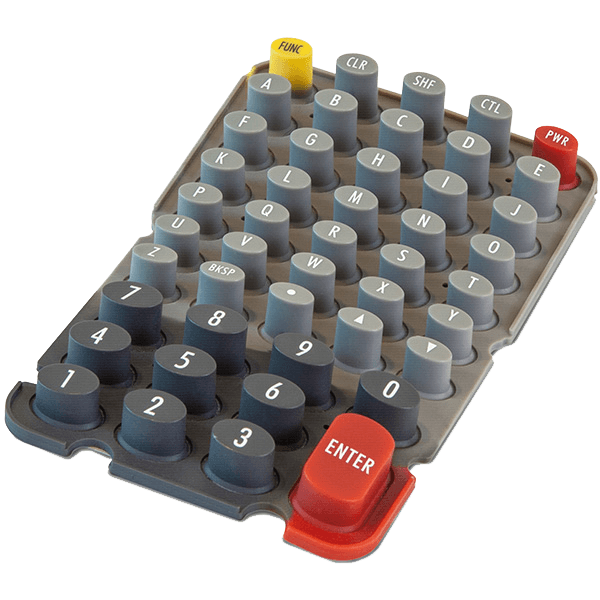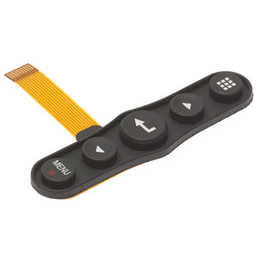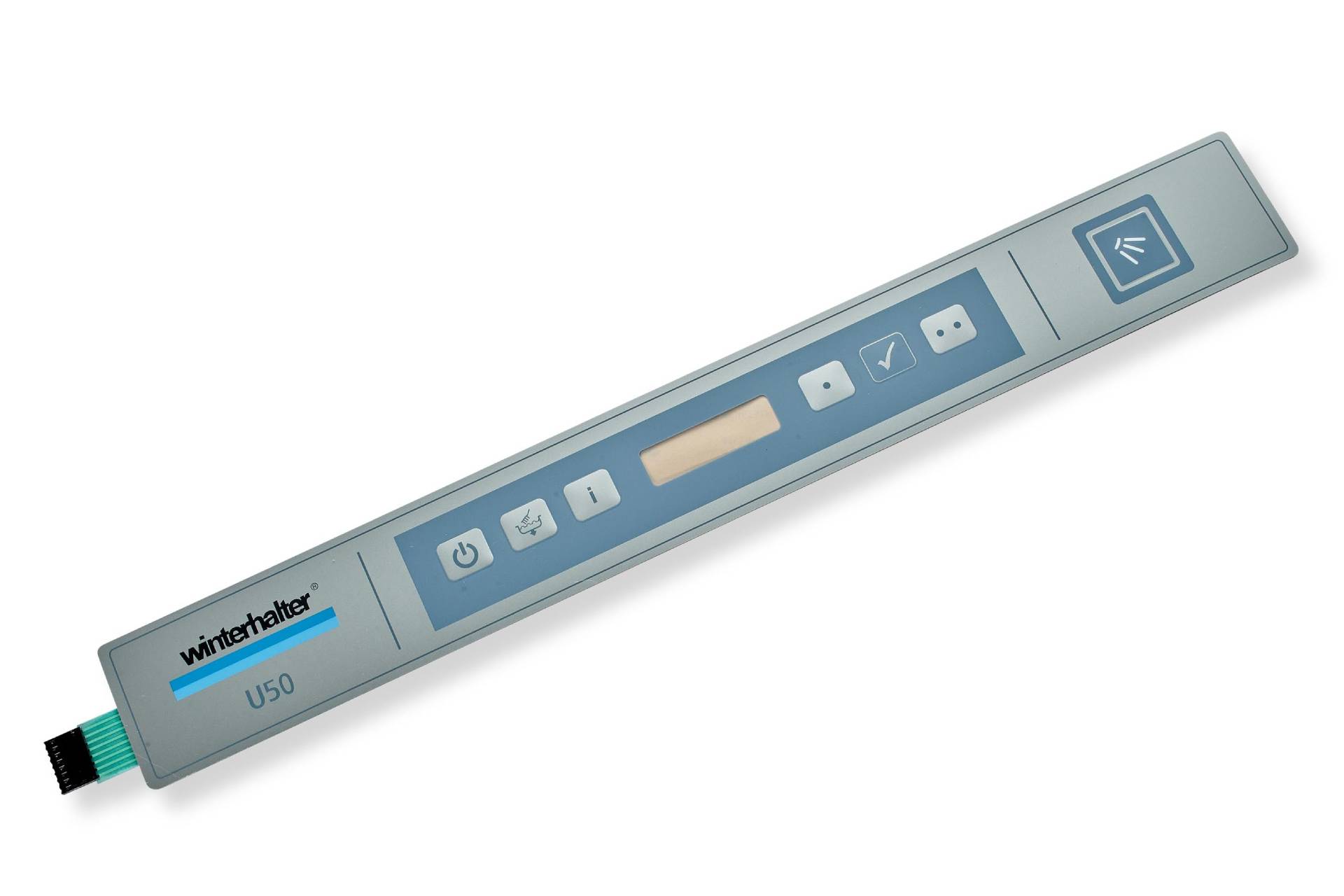Why LED-enhanced Rubber Keypads are gaining popularity in smart devices
Wiki Article
A Comprehensive Overview to the Manufacturing and Processing of Rubber Keypads for Optimal Performance
The production and handling of rubber keypads play a necessary duty in their efficiency and usability. Material option, design accuracy, and advanced manufacturing strategies substantially affect their resilience and performance. Comprehending these elements is crucial for developing top notch items. As different developments arise in this field, exploring their effects might reveal new standards for functionality and customer experience. What essential aspects will form the future of rubber keypads?Recognizing Rubber Keypads: Products and Kinds
Rubber keypads are essential parts in numerous tools, offering a balance of toughness and responsive comments. These keypads are largely made from silicone or synthetic rubber, materials chosen for their adaptability and strength. Silicone rubber, particularly, is preferred for its exceptional temperature level resistance and long life, making it optimal for different applications, from customer electronics to commercial equipment.There are a number of types of rubber keypads, consisting of dome switch keypads, which use a dome-shaped system that offers tactile feedback when pressed. In addition, there are likewise level keypads, which feature a smooth surface and are usually used in push-button controls and clinical gadgets. The selection of product and kind influences the keypad's performance, really feel, and total customer experience. Recognizing these facets is crucial for developers and suppliers aiming to create reliable and reliable interfaces in their products.
The Production Process: From Layout to Production
The manufacturing procedure of rubber keypads entails several crucial phases, beginning with design and ending with production. Originally, designers produce comprehensive requirements and prototypes, assuring the keypad fulfills practical and aesthetic needs. Computer-aided layout (CAD) software program is usually used to envision the layout and attributes before continuing.When the layout is wrapped up, material option is essential, with alternatives typically consisting of silicone or all-natural rubber. In the next stage, mold and mildews are produced based on the accepted layouts, which will shape the keypads during manufacturing.
Adhering to mold and mildew production, the production phase starts, where rubber is blended with additives to improve efficiency. The combination is after that poured into molds and based on heat and stress, allowing it to treat and solidify.
Lastly, the finished keypads go through high quality checks to validate they satisfy recognized requirements, followed by packaging for distribution. This comprehensive procedure warranties peak efficiency in the end product.
Key Methods in Rubber Molding
In the domain name of rubber keypads, various molding techniques play a crucial role in establishing the high quality and functionality of the end product. One prevalent approach is compression molding, where raw rubber is put in a warmed mold and pressure is used, enabling reliable automation and uniformity. An additional substantial strategy is shot molding, which includes injecting heated rubber right into a mold and mildew, supplying better precision and complex shapes. Transfer molding, a hybrid of both methods, is likewise made use of, particularly for intricate styles, as it combines the advantages of both processes. In addition, fluid silicone rubber (LSR) molding is obtaining grip as a result of its adaptability and toughness, making it excellent for high-performance applications. Each strategy has one-of-a-kind features, affecting variables such as cycle time, product waste, and manufacturing prices. Choosing the appropriate molding technique is essential for achieving peak efficiency in rubber keypads.Surface Area Finishing and Texturing Options
Surface ending up and texturing options play an important role in boosting the responsive experience and aesthetic appeal of rubber keypads. Suppliers use different strategies to develop distinct surface features that influence individual communication and item style. Typical finishing approaches consist of matte, shiny, and satin finishes, each supplying different visual results and grip degrees. Texturing alternatives, such as elevated patterns, grooves, or stippling, better boost performance by improving grip and decreasing slippage during usage.In addition, certain appearances can be tailored to meet ergonomic requirements, providing comfort throughout long term use. The selection of surface coatings and textures can be influenced by the designated application of the keypad, whether it be for customer electronics, vehicle controls, or industrial tools. Ultimately, cautious factor to consider of these options adds significantly to individual complete satisfaction and general item performance, making them vital components in the layout and manufacturing process of rubber keypads.
Top Quality Control Procedures in Rubber Keypad Manufacturing
Quality assurance measures in rubber keypad manufacturing are critical for guaranteeing item dependability and performance. These actions include material selection standards, rigorous screening treatments, and stringent last evaluation standards. With each other, they develop a complete structure that aids makers promote quality throughout the production procedure.
Material Option Standards
Picking the appropriate products for rubber keypads is vital, as it directly influences their toughness, capability, and customer experience. Trick standards for product choice include tensile stamina, strength, and ecological resistance. The option of rubber compound, such as silicone or polycarbonate elastomer (TPE), plays an essential function in attaining preferred tactile feedback and durability. Additionally, factors like chemical compatibility, temperature level stability, and UV resistance have to be thought about to assure maximum performance in numerous applications. Producers need to also examine the ease of handling and cost-effectiveness of products, stabilizing top quality with budget constraints. Eventually, the right material option not just enhances the keypad's performance however likewise adds to overall item quality and consumer satisfaction.Evaluating Procedures Applied
After identifying the proper products for rubber keypads, rigorous testing procedures are carried out to validate that the final items fulfill industry requirements and consumer expectations. These procedures normally consist of mechanical testing, which evaluates the resilience and elasticity of the rubber under different problems. Additionally, ecological screening analyzes the keypads' performance under temperature variations, moisture, and direct exposure to chemicals. Electric screening validates the keypads function correctly with digital parts, validating responsiveness and conductivity. Tactile feedback is evaluated to assure user complete satisfaction. These comprehensive screening procedures are crucial in recognizing any disparities or defects before automation, ultimately enhancing the integrity and performance of rubber keypads in their desired applications.
Final Assessment Specifications
Complete final assessment standards are vital in rubber keypad manufacturing to guarantee that each unit fulfills the specified standards for capability and look. This procedure normally involves aesthetic assessments to determine any surface flaws, such as discoloration or flaws. In addition, tactile examinations ascertain that the keypads respond properly to touch, preserving the needed degree of level of sensitivity. Sturdiness tests might also be performed, simulating extended use to validate the longevity of the keypad under different conditions. Adherence to sector laws and client specs is validated to preserve top quality assurance. By applying these strenuous inspection measures, producers can get redirected here considerably minimize the danger of issues, making certain that the end product is reliable and fulfills customer expectations, ultimately improving consumer complete satisfaction.Technologies in Rubber Keypad Innovation
As technology proceeds to progress, advancements in rubber keypad innovation are improving customer interfaces throughout numerous sectors. One significant development is the integration of capacitive touch sensing units within rubber keypads, allowing for a much more responsive and versatile user experience. This technology enables users to engage with tools via touch, improving functionality without giving up the tactile feedback that rubber keypads are known for.Furthermore, enhancements in material solutions have brought about the growth of more resilient, weather-resistant rubber, making keypads suitable for exterior and industrial use. Improved printing methods also permit high-resolution graphics and backlighting choices, enhancing visibility and visual appeal.

Moreover, developments in making procedures, such as 3D printing, are making it possible for custom-made designs and fast prototyping, streamlining manufacturing timelines. These developments collectively contribute to extra user-friendly and reliable rubber keypads, ensuring they satisfy the demands of modern applications while preserving their core advantages.
Finest Practices for Layout and Capability
Creating effective rubber keypads requires careful Click Here evaluation of both visual appeals and capability. Rubber Keypads. A properly designed keypad must stabilize ergonomic principles with visual interest enhance user experience. Trick factors include size, form, and spacing of buttons, ensuring they are easy to press while stopping unintended activation. Using contrasting appearances and shades can improve exposure and tactile feedback, assisting customers in distinguishing between keysAdditionally, the selection of materials plays an essential function; high-grade rubber substances can boost sturdiness and resistance to put on. It is likewise crucial to consider the assimilation of features such as backlighting and custom-made graphics, which can enhance functionality in various settings.
Prototyping and individual screening are vital in the layout procedure, allowing for changes based on real-world feedback. By sticking to these ideal techniques, producers can create rubber keypads that not just look attractive however likewise satisfy the functional demands of individuals effectively.
Frequently Asked Inquiries
Exactly how Do I Choose the Right Rubber Product for My Keypad?
To choose the ideal rubber product for a keypad, one ought to take into consideration variables such as toughness, ecological resistance, tactile feedback, and compatibility with the intended application, making certain ideal performance and user satisfaction in numerous conditions.What Are the Ecological Effects of Rubber Keypad Production?
Rubber keypad manufacturing can cause ecological impacts such as logging for natural rubber sources, contamination from chemical procedures, and waste generation. Sustainable techniques and materials can minimize some of these unfavorable effects on ecological communities.Can Rubber Keypads Be Recycled or Reused?
Rubber keypads can be recycled, but the process depends upon the specific products utilized in their manufacturing. Recycling them in different applications is also possible, contributing to lose reduction and promoting sustainability in making practices.What Is the Ordinary Life-span of a Rubber Keypad?
The average lifespan of a rubber keypad usually ranges from 5 to ten years, relying on usage, ecological factors, and upkeep. Routine care can prolong its capability, while extreme wear might shorten its longevity.Exist Any Kind Of Health Issues Associated to Rubber Keypad Products?
There are prospective wellness problems connected to rubber keypad materials, including allergic reactions to certain chemicals and irritants made use of in production. Correct handling and awareness of material composition can mitigate these risks for customers.There are numerous types of rubber keypads, consisting of dome button keypads, which use a dome-shaped mechanism that provides responsive responses when pressed. Selecting the appropriate materials for rubber keypads is necessary, as it directly impacts their capability, customer, and resilience experience - Rubber Keypads. After determining the suitable products for rubber keypads, strenuous screening procedures are applied to verify that the final products meet sector requirements and consumer expectations. Rubber keypad manufacturing can lead to environmental effects such as logging for natural rubber resources, contamination from chemical Continued procedures, and waste generation. Rubber keypads can be reused, however the procedure depends on the details products used in their production
Report this wiki page